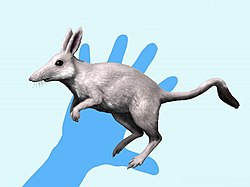| Hondonadia | |
|---|---|
| Scientific classification | |
| Domain: | Eukaryota |
| Kingdom: | Animalia |
| Phylum: | Chordata |
| Class: | Mammalia |
| Order: | † Polydolopimorphia |
| Family: | † Rosendolopidae |
| Genus: | † Hondonadia Goin & Candela, 1998 |
| Type species | |
| †Hondonadia feruglioi Goin & Candela, 1998 | |
| Species | |
| Synonyms | |
| |
Hondonadia is an extinct genus of Late Eocene to Early Oligocene (Tinguirirican) marsupials related to today's shrew opossums [ citation needed ] and with similar features as the related Rosendolops . The type species Hondonadia feruglioi was described by Goin and Candela in 1998. [1] In later years, five more species were recognized, of which Pascualdelphys fierroensis, described by Flynn and Wyss in 1999, [2] that was in 2010 synonymized with Hondonadia. [3]





